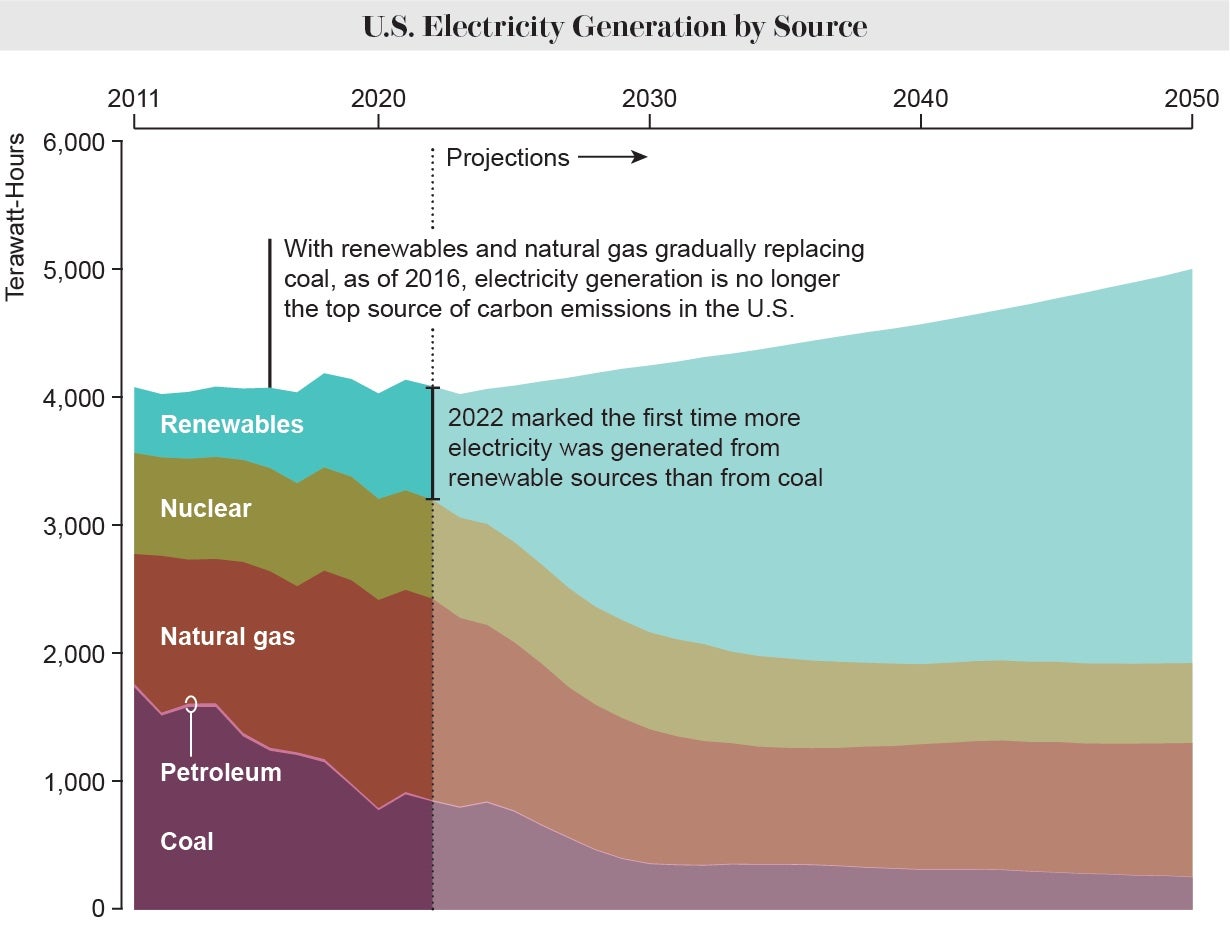Humanity is at a crossroads in choosing the way we will power our future. Depending on what electricity infrastructure we build now, we could lock in still more decades of planet-warming emissions, or we could lay a solid foundation for a clean energy future and stave off the climate emergency’s worst effects.
The choice is an urgent one because the window is quickly closing on our ability to meet the goal of the 2015 Paris climate agreement: keeping global temperature rise well below two degrees Celsius by the end of the century. The latest report from the Intergovernmental Panel on Climate Change (IPCC) stressed that the world needs fast and deep emissions cuts to meet that goal and eventually reach net zero emissions by 2050. Switching to renewable forms of power generation, such as solar, wind and hydropower, will be a key component of that effort. “The target is very ambitious,” says Heymi Bahar, a senior energy analyst at the International Energy Agency. And every year that goes by without major climate action, “we are basically losing the carbon [budget] that is left, and we need to go faster in a more expansive way. In that sense, most of the job, according to our models, needs to be done in the coming seven years,” Bahar says.
There are encouraging signs we are making this transition, such as substantial growth in renewable electricity generation in recent years. But there are still hurdles, and the rate of transition must accelerate, according to many experts in the field.
Globally, renewables account for about one third of electricity generation—and that share is rising. In 2022 renewable generation capacity grew by a record 295 gigawatts, according to the International Renewable Energy Agency (IRENA). Further, renewables accounted for more than 80 percent of all added power capacity last year, the agency reported.
Last year renewables produced more electricity than coal-powered plants for the first time in the U.S. Wind and solar now produce about 14 percent of the country’s electricity, up from virtually nothing just 25 years ago. The U.S. Energy Information Administration expects that more than half of electric generation capacity added to the nation’s grid in 2023 will be from solar energy.

The main reason renewable energy has grown so much in recent years is a dramatic decline in the expense of generating solar and wind power. The cost of solar photovoltaic cells has dropped a stunning 90 percent over the past decade, partly because of ramped-up manufacturing—particularly in China—Bahar says. Government subsidies in countries such as the U.S. also helped renewables grow in the early years, as did policies making commitments to renewable adoption, says Inês Azevedo, an associate professor in the department of energy science and engineering at Stanford University.* For example, many U.S. states set standards for how much of their electricity needs should be met with renewable energy by a particular year.
But the current rate of renewable adoption is still far below what is needed to meet climate goals. Though global renewables capacity grew by 9.6 percent last year, IRENA says the capacity needs to grow at triple that rate to meet the Paris climate goals. And as other sectors such as manufacturing and transportation decarbonize, electricity needs will only increase.
There are obstacles to accelerating the rate of adopting renewables, though. For one, solar and wind are intermittent power sources, meaning they need to be deployed with batteries or other types of energy storage; this can increase costs. Photovoltaic cells, as well as the lithium-ion batteries that are today’s key storage technology, also require critical (and sometimes relatively rare) minerals to produce them. Demand for these resources could outpace supply and create a future production bottleneck, Azevedo says.

Another impediment, she adds, is that “we’re not starting from scratch. We have this massive existing infrastructure that we spent a bunch of money on. Some of that, globally, has been built fairly recently, and so that creates the risk of stranded assets.” IRENA’s analysts have said that 41 percent of planned energy investment by 2050 still remains targeted at fossil fuels.
Strong government policies to reduce emissions will be essential to push renewable adoption, Azevedo says: “Regulators need to regulate. This is not going to get there just through market forces.”
Financing is also an issue. Even though the overall costs of renewables have come down, “you need to invest everything upfront,” Bahar says, “which means that financing cost and risk management is extremely important.”
Financing is particularly an issue in the equitable deployment of renewables. The U.S., Europe, India and China account for 80 percent of new renewables capacity. And “85 percent of investments in renewables has benefitted only 50 percent of the global population,” primarily in the world’s largest economies, says Roland Roesch, acting director of IRENA’s Innovation and Technology Center. He adds that multinational development banks (a key funding source for projects in developing countries) must support developing countries in adopting renewable projects—and that this could be done by addressing the upfront costs, as well as the added risk that can come from political instability in some places. “The last mile of net zero is the most difficult one,” Bahar says. “So it has to include everybody.”
*Editor’s Note (4/21/23): This sentence was edited after posting to clarify Inês Azevedo’s primary affiliation at Stanford University.


